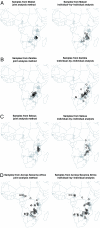Using DNA to track the origin of the largest ivory seizure since the 1989 trade ban
- PMID: 17360505
- PMCID: PMC1805457
- DOI: 10.1073/pnas.0609714104
Using DNA to track the origin of the largest ivory seizure since the 1989 trade ban
Abstract
The illegal ivory trade recently intensified to the highest levels ever reported. Policing this trafficking has been hampered by the inability to reliably determine geographic origin of contraband ivory. Ivory can be smuggled across multiple international borders and along numerous trade routes, making poaching hotspots and potential trade routes difficult to identify. This fluidity also makes it difficult to refute a country's denial of poaching problems. We extend an innovative DNA assignment method to determine the geographic origin(s) of large elephant ivory seizures. A Voronoi tessellation method is used that utilizes genetic similarities across tusks to simultaneously infer the origin of multiple samples that could have one or more common origin(s). We show that this joint analysis performs better than sample-by-sample methods in assigning sample clusters of known origin. The joint method is then used to infer the geographic origin of the largest ivory seizure since the 1989 ivory trade ban. Wildlife authorities initially suspected that this ivory came from multiple locations across forest and savanna Africa. However, we show that the ivory was entirely from savanna elephants, most probably originating from a narrow east-to-west band of southern Africa, centered on Zambia. These findings enabled law enforcement to focus their investigation to a smaller area and fewer trade routes and led to changes within the Zambian government to improve antipoaching efforts. Such outcomes demonstrate the potential of genetic analyses to help combat the expanding wildlife trade by identifying origin(s) of large seizures of contraband ivory. Broader applications to wildlife trade are discussed.
Conflict of interest statement
The authors declare no conflict of interest.
Figures


References
-
- Martin E, Stiles D. The Ivory Markets of Africa. Nairobi: Save the Elephants; 2000.
-
- Stiles D, Martin E. Pachyderm. 2001;30:24–36.
-
- Martin E, Stiles D. The Ivory Markets of East Asia. Nairobi: Save the Elephants; 2003.
-
- Martin E. Pachyderm. 2005;39:67–76.
-
- Clark B. Between the Conference of the Parties. 2006;6:6–7.
Publication types
MeSH terms
Substances
LinkOut - more resources
Full Text Sources

